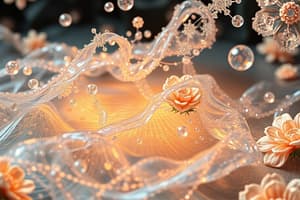Podcast
Questions and Answers
What type of lens converges light rays to a focal point?
What type of lens converges light rays to a focal point?
- Cylindrical Lens
- Convex Lens (correct)
- Biconcave Lens
- Concave Lens
Concave lenses create a virtual image that appears larger than the object.
Concave lenses create a virtual image that appears larger than the object.
False (B)
What is the distance from the center of the lens to the focal point called?
What is the distance from the center of the lens to the focal point called?
focal length
Concave lenses are often used in eyeglasses for __________.
Concave lenses are often used in eyeglasses for __________.
Match the following types of lenses with their characteristics:
Match the following types of lenses with their characteristics:
How are convex lenses typically used in biophysics?
How are convex lenses typically used in biophysics?
The power of a diverging lens is defined as positive.
The power of a diverging lens is defined as positive.
What is the primary reason light behaves as both a wave and a particle?
What is the primary reason light behaves as both a wave and a particle?
What is the definition of magnification?
What is the definition of magnification?
A virtual image formed by a converging lens is projected on the retina.
A virtual image formed by a converging lens is projected on the retina.
What type of magnification is used in optical instruments like telescopes?
What type of magnification is used in optical instruments like telescopes?
When an object is placed closer to the focal length of a converging lens, the image is called a ______.
When an object is placed closer to the focal length of a converging lens, the image is called a ______.
What sign does magnification take when the image is inverted?
What sign does magnification take when the image is inverted?
Match the following terms with their descriptions:
Match the following terms with their descriptions:
Total magnification in microscopes is the result of multiplying the magnification of the objective and eyepiece lenses.
Total magnification in microscopes is the result of multiplying the magnification of the objective and eyepiece lenses.
What is the primary function of surfactants?
What is the primary function of surfactants?
What happens to the height of the image when the object is closer to the lens than its focal length?
What happens to the height of the image when the object is closer to the lens than its focal length?
Surfactants have both hydrophilic and hydrophobic ends.
Surfactants have both hydrophilic and hydrophobic ends.
What happens to surfactant molecules when they are placed in water?
What happens to surfactant molecules when they are placed in water?
The bending of light when it enters a medium where its speed is different is called __________.
The bending of light when it enters a medium where its speed is different is called __________.
What does Snell's Law describe?
What does Snell's Law describe?
Match the terms related to refraction with their definitions:
Match the terms related to refraction with their definitions:
The first law of refraction states that the incident ray, refracted ray, and normal lie in different planes.
The first law of refraction states that the incident ray, refracted ray, and normal lie in different planes.
The surface tension of water can be reduced from 73 dyn/cm to __________ dyn/cm by surfactants.
The surface tension of water can be reduced from 73 dyn/cm to __________ dyn/cm by surfactants.
What is one primary function of phase contrast microscopy?
What is one primary function of phase contrast microscopy?
Fluorescence microscopy can only be used with naturally pigmented samples.
Fluorescence microscopy can only be used with naturally pigmented samples.
What is the main benefit of confocal microscopy?
What is the main benefit of confocal microscopy?
___ microscopy is the simplest form where light passes through the sample.
___ microscopy is the simplest form where light passes through the sample.
Match the microscopy types with their features:
Match the microscopy types with their features:
Which application of optics in biophysics utilizes focused light to manipulate small biological particles?
Which application of optics in biophysics utilizes focused light to manipulate small biological particles?
Optical techniques have no role in medical diagnostics.
Optical techniques have no role in medical diagnostics.
Name one microscopy technique that allows for the observation of living cells without staining.
Name one microscopy technique that allows for the observation of living cells without staining.
What does the index of refraction measure?
What does the index of refraction measure?
Total internal reflection can occur when light travels from a medium with a lower refractive index to a medium with a higher refractive index.
Total internal reflection can occur when light travels from a medium with a lower refractive index to a medium with a higher refractive index.
What is the approximate index of refraction for diamond?
What is the approximate index of refraction for diamond?
The equation for calculating specific gravity (SG) from Brix is SG = 1 + (0.004 x ______).
The equation for calculating specific gravity (SG) from Brix is SG = 1 + (0.004 x ______).
Match the following substances with their index of refraction:
Match the following substances with their index of refraction:
What happens when the angle of incidence exceeds the critical angle?
What happens when the angle of incidence exceeds the critical angle?
Brix and Plato are both defined as 1 gram of sucrose in 100 grams of total solution.
Brix and Plato are both defined as 1 gram of sucrose in 100 grams of total solution.
Define the critical angle in terms of light refraction.
Define the critical angle in terms of light refraction.
Flashcards
Surfactant
Surfactant
A molecule that reduces the surface tension of a liquid.
Hydrophilic
Hydrophilic
The part of a surfactant molecule that is attracted to water.
Hydrophobic
Hydrophobic
The part of a surfactant molecule that repels water.
Refraction
Refraction
Signup and view all the flashcards
Index of Refraction
Index of Refraction
Signup and view all the flashcards
Snell's Law
Snell's Law
Signup and view all the flashcards
Incident Ray
Incident Ray
Signup and view all the flashcards
Refracted Ray
Refracted Ray
Signup and view all the flashcards
Object Distance (do)
Object Distance (do)
Signup and view all the flashcards
Image Distance (di)
Image Distance (di)
Signup and view all the flashcards
Magnification (m)
Magnification (m)
Signup and view all the flashcards
Virtual Image
Virtual Image
Signup and view all the flashcards
Real Image
Real Image
Signup and view all the flashcards
Converging Lens
Converging Lens
Signup and view all the flashcards
Diverging Lens
Diverging Lens
Signup and view all the flashcards
Magnifying Lens
Magnifying Lens
Signup and view all the flashcards
Critical Angle
Critical Angle
Signup and view all the flashcards
Total Internal Reflection
Total Internal Reflection
Signup and view all the flashcards
Brix
Brix
Signup and view all the flashcards
Plato
Plato
Signup and view all the flashcards
Specific Gravity
Specific Gravity
Signup and view all the flashcards
Brix to Specific Gravity conversion
Brix to Specific Gravity conversion
Signup and view all the flashcards
Brix Refractometer
Brix Refractometer
Signup and view all the flashcards
Optics
Optics
Signup and view all the flashcards
Lens
Lens
Signup and view all the flashcards
Convex Lens
Convex Lens
Signup and view all the flashcards
Concave Lens
Concave Lens
Signup and view all the flashcards
Focal Point
Focal Point
Signup and view all the flashcards
Focal Length
Focal Length
Signup and view all the flashcards
Image Formation by Thin Lenses
Image Formation by Thin Lenses
Signup and view all the flashcards
Focal Point of a Concave Lens
Focal Point of a Concave Lens
Signup and view all the flashcards
Brightfield Microscopy
Brightfield Microscopy
Signup and view all the flashcards
Fluorescence Microscopy
Fluorescence Microscopy
Signup and view all the flashcards
Phase Contrast Microscopy
Phase Contrast Microscopy
Signup and view all the flashcards
Confocal Microscopy
Confocal Microscopy
Signup and view all the flashcards
Biophysics
Biophysics
Signup and view all the flashcards
Optical Trap
Optical Trap
Signup and view all the flashcards
Optical Techniques in Medical Diagnostics
Optical Techniques in Medical Diagnostics
Signup and view all the flashcards
Cell Biology Applications of Optics
Cell Biology Applications of Optics
Signup and view all the flashcards
Study Notes
SURFACTANTS
- Surfactants are molecules that reduce the surface tension of liquids. This is also known as a surface active agent.
- Common surfactants have a water-soluble (hydrophilic) end and a water-insoluble (hydrophobic) end.
- The hydrophilic end is strongly attracted to water, while the hydrophobic end is attracted to oily liquids.
- Many surfactants appear in nature and are generated in laboratories.
EFFECT OF SURFACTANTS IN WATER
- When surfactants are added to water, they align with the hydrophobic end pointing outward away from the water.
- This alignment disrupts the surface structure of water, decreasing surface tension.
- A small concentration of surfactant can reduce water's surface tension from 73 dyn/cm to 30 dyn/cm.
TYPES OF SURFACTANTS
- Surfactants can be categorized as non-ionic, anionic, cationic, or amphoteric.
- These categories differ in the chemical makeup of their hydrophilic end.
SURFACTANTS IN OILY LIQUIDS
- In oily liquids, surfactants align with the hydrophilic end pointing outward away from the oil.
- This alignment leads to a reduction in the oil's surface tension.
- Soaps and detergents use surfactants. The hydrophobic end dissolves into oily substances and the hydrophilic end is exposed to water, cleaning the oily substance.
REFRACTION (OPTICS)
- Refraction is the bending of a wave as it passes from one medium to another where its speed is different.
- Light bends towards the normal when crossing from a fast medium to a slow medium. The amount of bending depends on the index of refraction of both media.
- Snell's Law governs the relationship between refractive index and angles of incidence and refraction.
LAWS OF REFRACTION
- Incident ray, refracted ray, and the normal at the point of incidence all lie in the same plane.
- Snell's Law: n₁ sin θ₁ = n₂ sin θ₂ , where n₁ and n₂ are the refractive indices of the first and second media, respectively, and θ₁ and θ₂ are the angles of incidence and refraction.
INDEX OF REFRACTION
- The index of refraction (n) is the ratio of the speed of light in a vacuum to the speed of light in a medium.
- Air, water, glass, and diamond have different values for their refractive index.
- The higher the index of refraction, the more light bends entering the medium.
CRITICAL ANGLE AND TOTAL INTERNAL REFLECTION
- The critical angle is the minimum angle of incidence at which light, travelling from a higher refractive index medium to a lower one, is refracted along the boundary instead of passing into the second medium.
- Total internal reflection occurs when the angle of incidence exceeds the critical angle, resulting in all light reflecting back into the first medium.
BRIX REFRACTOMETERS
- Brix refractometers measure sugar concentration in a sucrose solution, often provided as percent by mass.
- Specific gravity is also a way to quantify the amount of sugar in a liquid.
FUNDAMENTALS OF OPTICS IN BIOPHYSICS
- Optics is the branch of physics investigating light behavior and properties.
- Light exhibits wave-particle duality (both wave-like and particle-like behavior).
- Lenses are optical devices that manipulate light to create images.
TYPES OF LENSES
- Convex lenses converge light rays to a focal point, used to magnify small objects.
- Concave lenses diverge light rays, creating virtual images that appear smaller than the object, often used in eyeglasses.
IMAGE FORMATION BY THIN LENSES
- Object distance (d₀), image distance (dᵢ), focal length (f), and height of object (h₀) and height of image (hᵢ) are important variables in image formation analysis. Equations relating these variables exist ( Thin Lens Equations ).
- Converging lenses can produce real or virtual images depending on the object's position relative to the focal point.
- The image formed is farther away on the same side of the lens as the object. It is called a virtual image and cannot be projected.
MAGNIFICATION
- Magnification is the ratio of image size to object size. A magnification greater than 1 means the image is larger than the object.
- Linear magnification (M) is given by M = hᵢ/h₀ = dᵢ/d₀.
MICROSCOPY TECHNIQUES IN BIOPHYSICS
- Microscopy is a crucial technique in biophysics for visualizing biological samples.
- Different microscopy techniques including brightfield, phase contrast, fluorescence, and confocal microscopy are used to visualize samples at various levels, including cellular and molecular.
APPLICATIONS OF OPTICS IN BIOPHYSICS
- Optic principles, lenses, and microscopes are essential in biophysics to investigate diverse processes such as cell biology, medical diagnostics, or biological research involving particles and dynamics.
Studying That Suits You
Use AI to generate personalized quizzes and flashcards to suit your learning preferences.





